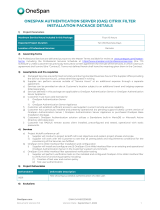
SonicWall Secure Mobile Access 12.2 Workplace User Guide
Using Secure Mobile Access WorkPlace
6
Logging into WorkPlace
Before you can access your WorkPlace resources, your identity must be verified. Depending on how your
administrator has configured WorkPlace, this might mean selecting a specific login group (for example,
“Employees” or “Partners”), and then providing credentials. You may be prompted for a username and
password, which you can type in or enter by means of a virtual keyboard, or you may be prompted for some
other form of credentials.
1 If you are presented with a Please log in prompt, select the appropriate group from the list. (This
information is provided by your system administrator.) If the list does not contain the appropriate name,
select Other from the list, and then type the group name in the box below the Log in to box.
2 Click Next.
3 If configured by your administrator, the Acceptable Use Policy screen (AUP) appears. The AUP displays
specific messages or instructions you will need to agree to. Click Accept to continue. If you do not accept
the license agreement, you will not be able to access WorkPlace.
4 If logging in with a personal device for the first time Device Authorization Terms are displayed. Read and
agree to the terms to login.
5 When prompted for credentials, enter them, and then click Login.
Your administrator can offer an alternative method for providing your credentials using a virtual
keyboard. Some administrators may even require it if, for example, there is concern that a user’s login
credentials might be stolen. To enter your credentials without typing them, click Use virtual keyboard
and point to characters on the keyboard display.
6 If CAPTCHA authentication is enabled for your realm, a CAPTCHA verification display and prompt appear.
Type the 6-character case sensitive alphanumeric CAPTCHA value. To view a different CAPTCHA, click the
New button.
7 Windows users are prompted to install the Secure Endpoint Manager (SEM), which takes care of
installing agents and clients through the browser. Once it is installed, you automatically receive client
updates. Click Continue, then click Run and accept the software if any security warnings appear.
• The URL you use to log in to WorkPlace is provided by your system administrator.
• Depending on how your administrator has configured WorkPlace, all other open browser
windows may automatically close at WorkPlace startup, leaving only the WorkPlace browser
window open.
• Your administrator can configure the SEM to start automatically when the operating system starts
(Windows only).
• In some cases, you may be prompted to accept a security warning before WorkPlace can start. For
more information, see Using Cache Cleaner.
Topics:
• Changing Your Password
• Entering Credentials Using the Virtual Keyboard
NOTE: Keyboard entry may not be accepted when using RDP in full screen mode on
Mac OS X.




















